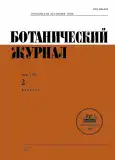GYNODIOECY IN NEPETA GONTSCHAROVII (LAMIACEAE)
- Авторлар: Godin V.N.1, Astashenkov A.Y.1, Cheryomushkina V.A.1
-
Мекемелер:
- Central Siberian Botanical Garden SB RAS
- Шығарылым: Том 108, № 2 (2023)
- Беттер: 155-162
- Бөлім: COMMUNICATIONS
- URL: https://journals.rcsi.science/0006-8136/article/view/134482
- DOI: https://doi.org/10.31857/S0006813623020047
- EDN: https://elibrary.ru/EXGEUC
- ID: 134482
Дәйексөз келтіру
Толық мәтін
Аннотация
Gynodioecy is described for the first time in Nepeta gontscharovii, an endemic herbaceous polycarpic plant from the Hissar Darvaz mountains (Tajikistan). N. gontscharovii forms the flowers of two types: perfect and pistillate, on different plants. Both types of flowers are median zygomorphic, tetracyclic, and heteromeric: pentameric in the perianth, tetrameric in the androecium, and dimeric in the gynoecium. The stamens in pistillate flowers have transformed into staminodes. We have observed that the values of the vast majority of the studied morphological traits in perfect flowers are larger than in the pistillate ones. Three criteria have been identified which allow to distinguish reliably the flowers of different sexual forms: the size of flowers and their parts, the ratio of the length of corolla tube and calyx, and the position of anthers. The perfect flowers are characterized by pronounced protandry. According to the determined pollen/ovules ratio (from 1286 to 1657), N. gontscharovii is to be considered as a facultative xenogamous species. Females were rare (6.6%) in the studied population. We discuss the presence and distribution of gynodioecy within the genus Nepeta and section Macronepeta and its adaptive significance for the N. gontscharovii population.
Негізгі сөздер
Авторлар туралы
V. Godin
Central Siberian Botanical Garden SB RAS
Хат алмасуға жауапты Автор.
Email: vn.godin@mpgu.su
Russia, 630090, Novosibirsk, Zolotodolinskaya Str., 101
A. Astashenkov
Central Siberian Botanical Garden SB RAS
Email: vn.godin@mpgu.su
Russia, 630090, Novosibirsk, Zolotodolinskaya Str., 101
V. Cheryomushkina
Central Siberian Botanical Garden SB RAS
Email: vn.godin@mpgu.su
Russia, 630090, Novosibirsk, Zolotodolinskaya Str., 101
Әдебиет тізімі
- Barrett S.C.H., Wilken D.H., Cole W.W. 2000. Heterostyly in the Lamiaceae: the case of Salvia brandegeei. – Plant Syst. Evol. 223 (3–4): 211–219. https://doi.org/10.1007/BF00985280
- Budantsev A.L. 1993. A synopsis of the genus Nepeta (Lamiaceae). – Bot. Zhurn. 78 (1): 93–107 (In Russ.).
- Cruden R.W. 1977. Pollen-ovule ratios: a conservative indicator of breeding systems in flowering plants. – Evolution. 31 (1): 32–46. https://doi.org/10.1111/j.1558-5646.1977.tb00979.x
- Daskalova T. 2005. Polygamy in some species of Nepeta (Lamiaceae). – Phytologia Balcanica. 11 (1): 79–88.
- Demyanova E.I. 1981. About the features of the extent of gynodioecy in Lamiaceae. – Biol. Nauki. 9: 69–73 (In Russ.).
- Demyanova E.I. 1985. Distribution of gynodioecy in flowering plants. – Bot. Zhurn. 70 (10): 1289–1301 (In Russ.).
- Demyanova E.I. 2013. Sexual polymorphism of some steppe plants of Central Chernozyomnii Reserve. – Bulletin of Perm University. Biology. 2: 11–18 (In Russ.).
- Demyanova E.I. 2019. Concerning sexual polymorphism in Nepeta L. – Bulletin of Perm University. Biology. 1: 12–20 (In Russ.). https://doi.org/10.17072/1994-9952-2019-1-12-20
- Fedorov Al.A., Artyushenko Z.T. 1975. Organographia illustrata plantarum vascularum. Flos. Leningrad. 351 p. (In Russ.).
- Godin V.N. 2009. Flower morphology of Schizonepeta multifida (Lamiaceae) in the context of their sex differentiation. – Bot. Zhurn. 94 (12): 1784–1790 (In Russ.).
- Godin V.N. 2014. Sexual structure of coenopopulations of Schizonepeta multifida (Lamiaceae) in Kuznetsk Highland. – Flora and Vegetation of Asian Russia. 3 (15): 39–43 (In Russ.).
- Godin V.N. 2019. Distribution of gynodioecy in APG IV system. – Bot. Zhurn. 104 (5): 345–356 (In Russ.). https://doi.org/10.1134/S0006813619050053
- Godin V.N. 2020. Distribution of gynodioecy in flowering plants. – Bot. Zhurn. 105 (3): 236–252 (In Russ.). https://doi.org/10.31857/S0006813620030023
- Huck R.B. 1992. Overview of pollination biology in the Labiatae. – In: Advances in Labiate science. Kew. P. 167–181.
- Knuth P. 1898. Handbuch der Blütenbiologie. Bd. II. T. I. Leipzig. 697 S.
- Kochkareva T.F. 1986. Genus 739. Nepeta L. – In: Flora Tadzhikskoy SSR. Leningrad. P. 104–142 (In Russ.).
- Kokkini S., Babalonas D. 1982. Morphological variation in Nepeta nuda L. – Fedd. Repert. 93 (1–2): 71–76. https://doi.org/10.1002/fedr.19820930110
- Lloyd D.G. 1976. The transmission of genes via pollen and ovules in gynodioecious angiosperms. – Theor. Popul. Biol. 9 (3): 299–316. https://doi.org/10.1016/0040-5809(76)90050-2
- Lloyd D.G., Webb C.J. 1986. The avoidance of interference between the presentation of pollen and stigmas in angiosperms. I. Dichogamy. – N. Z. J. Bot. 24 (1): 135–162. https://doi.org/10.1080/0028825X.1986.10409725
- Maurice S., Charlesworth D., Desfeux C., Couvet D., Gouyon P.-H. 1993. Evolution of gender in hermaphrodites of gynodioecious populations with nucleo-cytoplasmic male-sterility. – Proc. R. Soc. Lond. B. 251 (1332): 253–261. https://doi.org/10.2307/49859
- Meehan T. 1889. On Gyno-Dioecious Labiatae. – Bull. Torr. Bot. Club 16 (2): 49–51. https://doi.org/10.2307/2476539
- Moon H.-K. 2021. Confirmation of distyly in Perovskia and floral dimorphism of P. abrotanoides (Salviinae: Lamiaceae). – Flora. 283. 151905. https://doi.org/10.1016/j.flora.2021.151905
- Owens S.J., Ubera-Jiménez J.L. 1992. Breeding systems in Labiatae. – In: Advances in Labiate science. Kew. P. 257–280.
- Poyarkova A.I. 1954. Genus 1254. Nepeta L. – In: Flora USSR. Vol. 20. Moscow–Leningrad. P. 286–437.
- Ronse de Craene L.P. 2010. Floral Diagrams. An aid to understanding flower morphology and evolution. Cambridge University Press. 441 p.
- Sokal R.R., Rohlf F.J. 2012. Biometry: the principles and practice of statistics in biological research. 4th edition. New York. 937 p.
- Webb C.J. 1979. Breeding systems and the evolution of dioecy in New Zealand apioid Umbelliferae. – Evolution. 33 (2): 662–672. https://doi.org/10.1111/j.1558-5646.1979.tb04719.x
- Webb C.J. 1981. Test of a model predicting equilibrium frequencies of females in populations of gynodioecious angiosperms. – Heredity. 46 (3): 397–405. https://doi.org/10.1038/hdy.1981.48
Қосымша файлдар










